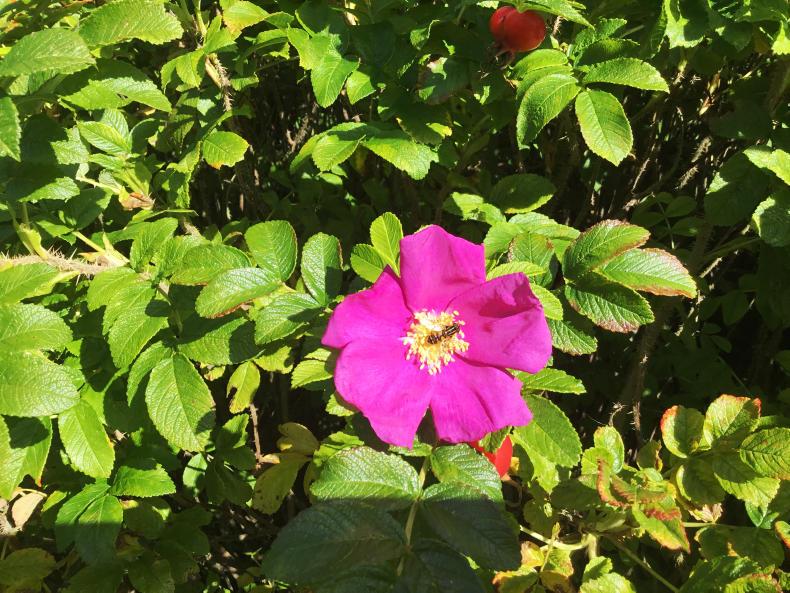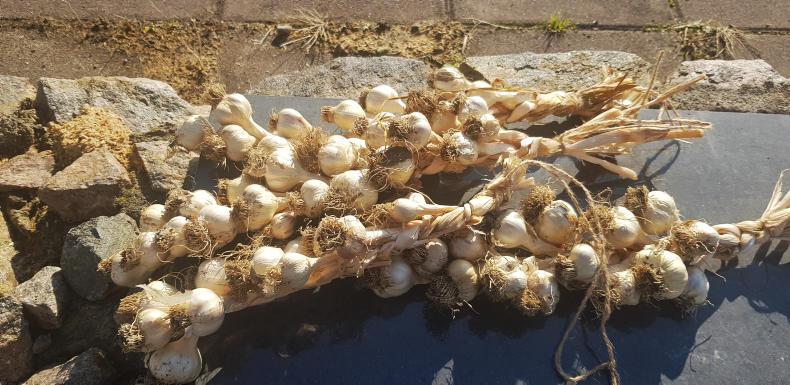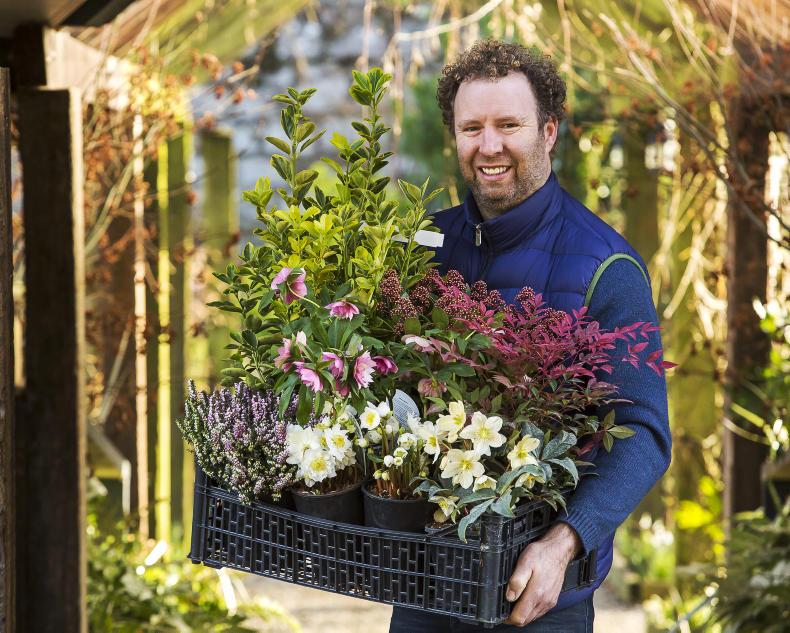When we joined the Rural Environment Protection scheme (REPS) we had to plant about 250 metres of whitethorn hedging. The location is very windy and growth was uneven. So we are left with this higgledy pigidly hedge.
We tried planting some beech at intervals along it but most of them never got going so now as well as being uneven there’s gaps all through it. If I had my way I’d take a chainsaw to the lot of it and start all over again.
I do like a nice green beech hedge. It’s a real winner in spring as the newly unfurled vivid green leaves light up the garden. A good beech hedge gives structure to a garden, creates interest all year round and protects the little birds. We have a successful east facing beech hedge in the garden but it’s not tough enough to withstand the westerly winds on the avenue.

Rosa rugosa makes a great hedge and produces roses in shades from white to deep purple all through the summer.
By far the most successful hedge we’ve ever planted is Rosa rugose. I remember the bare rooted plants coming in two fertiliser bags, plenty for a 90 metre hedge. We planted them along a post and rail fence and that has disappeared as the Rosa rugosa has a suckering habit and quickly colonised the space.
The first buds on Rosa rugose appear as early as February, By April the lime green leaves have appeared and the roses aren’t far behind. The roses are the size of saucers and range in colour from white to deep purple. They are not long lasting but that’s OK as the roses keep coming throughout the summer.
The roses are followed by a show of hips in shades of orange to deep red. The hips are the size of plum tomatoes and are great feed for the birds up to Christmas. The leaves also turn a burnt orange and survive up to December.
Rosa rugose grows to about ten feet in height and likes full sun and a damp but well drained soil. We cut it back to about 30 inches every second year. You can take a hedge cutter to it or attack it with secateurs and lobbers. I dare any animal to break through it – another good reason for it to be seen more often on farms.
What I love to grow: Margaret Leahy
If it’s true that vampires are deterred by garlic, then I am doing my bit to keep Connemara free of the bloodsuckers. Growing your own garlic is relatively easy and I keep extending the garlic growing area a little every year hoping to be self-sufficient. This is quiet an ask as I use garlic not only for cooking but also in the garden.

Now is a good time to start sowing garlic
In the kitchen I use it in soups, stews, curries and everything Italian. Garlic has anti-viral properties so the minute I get a sniffle I prescribe myself lots of yummy garlic bread. In the garden it’s a fungicide, insect repellent and I always plant some around the roses and fruit trees. Even the hens get a clove in their drinking water and no, their eggs won’t taste of garlic.
Most garlic for sale is grown in China so comes with a hefty carbon footprint and who knows what it has been sprayed with. Why not grow your own? Even one bulb, divided into cloves, each of which is planted separately will give you 10 or 12 lovely smelly bulbs next summer.
Some plant it on the shortest day of the year, 21 December and harvest on the longest day 21 June. I tried this, but even avid gardeners like me have enough to be doing on the 21 December. I plant a few different varieties ordered from good Irish suppliers in October/November and they grow away needing just a hoe to keep down the weeds. Then in July when they are harvested, I get to try my hand at plaiting them – an underutilised skill since my daughters grew up.
Margaret Leahy lives and gardens by the sea in Co Galway and shares her successes and failures online as @gardenngather.
Get cracking and plant bulbs, remember those you bought at the Ploughing. I find planting bulbs very satisfying. They look like nothing going into the ground and reward you with a great display of colour from January onwards.
If you don’t feel like digging up ground, find a few pots, buckets, sinks – anything at all – and add several layers of bulbs and compost so they won’t all appear at the same time.
Last year, I planted bunches of the heavily scented ‘Bridal Crown’ daffodil and they were gorgeous. Another favourite is ‘Pheasants Eye’ with its elegant white petals and red rimmed cup.
This autumn, I’ve set aside a piece of ground in the orchard and scatter planted about 50 alliums across it. In theory, it should look stunning in June. I’d love to hear from anyone who has tried doing this.
The garden centre recommends
From now until the end of November is a great time to get work done in the garden. “The ground is still warm so roots establish easily. However, unlike planting in summer where you can see height and spread, in autumn you need a bit of vision and belief that the little bulb or cutting will turn into something worthwhile,” says Robert Miller who owns Altamont Plant Sales near Tullow, Co Carlow.

Robert Miller of Altamont Plant Sales. \ Philip Doyle
This is a great time of year for planting both potted and bare rooted trees. While we’ve had weeks of heavy rain ground conditions are good enough. Robert suggests planting trees that will have interest over two seasons. “You need to think about trees with good flowers, berries, fruit and striking leaf colour in autumn. Any variety of sorbus would fit the bill with its spring flowers and berries in autumn. Dogwoods are also good for flowers and autumn colour.”
When we joined the Rural Environment Protection scheme (REPS) we had to plant about 250 metres of whitethorn hedging. The location is very windy and growth was uneven. So we are left with this higgledy pigidly hedge.
We tried planting some beech at intervals along it but most of them never got going so now as well as being uneven there’s gaps all through it. If I had my way I’d take a chainsaw to the lot of it and start all over again.
I do like a nice green beech hedge. It’s a real winner in spring as the newly unfurled vivid green leaves light up the garden. A good beech hedge gives structure to a garden, creates interest all year round and protects the little birds. We have a successful east facing beech hedge in the garden but it’s not tough enough to withstand the westerly winds on the avenue.

Rosa rugosa makes a great hedge and produces roses in shades from white to deep purple all through the summer.
By far the most successful hedge we’ve ever planted is Rosa rugose. I remember the bare rooted plants coming in two fertiliser bags, plenty for a 90 metre hedge. We planted them along a post and rail fence and that has disappeared as the Rosa rugosa has a suckering habit and quickly colonised the space.
The first buds on Rosa rugose appear as early as February, By April the lime green leaves have appeared and the roses aren’t far behind. The roses are the size of saucers and range in colour from white to deep purple. They are not long lasting but that’s OK as the roses keep coming throughout the summer.
The roses are followed by a show of hips in shades of orange to deep red. The hips are the size of plum tomatoes and are great feed for the birds up to Christmas. The leaves also turn a burnt orange and survive up to December.
Rosa rugose grows to about ten feet in height and likes full sun and a damp but well drained soil. We cut it back to about 30 inches every second year. You can take a hedge cutter to it or attack it with secateurs and lobbers. I dare any animal to break through it – another good reason for it to be seen more often on farms.
What I love to grow: Margaret Leahy
If it’s true that vampires are deterred by garlic, then I am doing my bit to keep Connemara free of the bloodsuckers. Growing your own garlic is relatively easy and I keep extending the garlic growing area a little every year hoping to be self-sufficient. This is quiet an ask as I use garlic not only for cooking but also in the garden.

Now is a good time to start sowing garlic
In the kitchen I use it in soups, stews, curries and everything Italian. Garlic has anti-viral properties so the minute I get a sniffle I prescribe myself lots of yummy garlic bread. In the garden it’s a fungicide, insect repellent and I always plant some around the roses and fruit trees. Even the hens get a clove in their drinking water and no, their eggs won’t taste of garlic.
Most garlic for sale is grown in China so comes with a hefty carbon footprint and who knows what it has been sprayed with. Why not grow your own? Even one bulb, divided into cloves, each of which is planted separately will give you 10 or 12 lovely smelly bulbs next summer.
Some plant it on the shortest day of the year, 21 December and harvest on the longest day 21 June. I tried this, but even avid gardeners like me have enough to be doing on the 21 December. I plant a few different varieties ordered from good Irish suppliers in October/November and they grow away needing just a hoe to keep down the weeds. Then in July when they are harvested, I get to try my hand at plaiting them – an underutilised skill since my daughters grew up.
Margaret Leahy lives and gardens by the sea in Co Galway and shares her successes and failures online as @gardenngather.
Get cracking and plant bulbs, remember those you bought at the Ploughing. I find planting bulbs very satisfying. They look like nothing going into the ground and reward you with a great display of colour from January onwards.
If you don’t feel like digging up ground, find a few pots, buckets, sinks – anything at all – and add several layers of bulbs and compost so they won’t all appear at the same time.
Last year, I planted bunches of the heavily scented ‘Bridal Crown’ daffodil and they were gorgeous. Another favourite is ‘Pheasants Eye’ with its elegant white petals and red rimmed cup.
This autumn, I’ve set aside a piece of ground in the orchard and scatter planted about 50 alliums across it. In theory, it should look stunning in June. I’d love to hear from anyone who has tried doing this.
The garden centre recommends
From now until the end of November is a great time to get work done in the garden. “The ground is still warm so roots establish easily. However, unlike planting in summer where you can see height and spread, in autumn you need a bit of vision and belief that the little bulb or cutting will turn into something worthwhile,” says Robert Miller who owns Altamont Plant Sales near Tullow, Co Carlow.

Robert Miller of Altamont Plant Sales. \ Philip Doyle
This is a great time of year for planting both potted and bare rooted trees. While we’ve had weeks of heavy rain ground conditions are good enough. Robert suggests planting trees that will have interest over two seasons. “You need to think about trees with good flowers, berries, fruit and striking leaf colour in autumn. Any variety of sorbus would fit the bill with its spring flowers and berries in autumn. Dogwoods are also good for flowers and autumn colour.”









 This is a subscriber-only article
This is a subscriber-only article










SHARING OPTIONS: